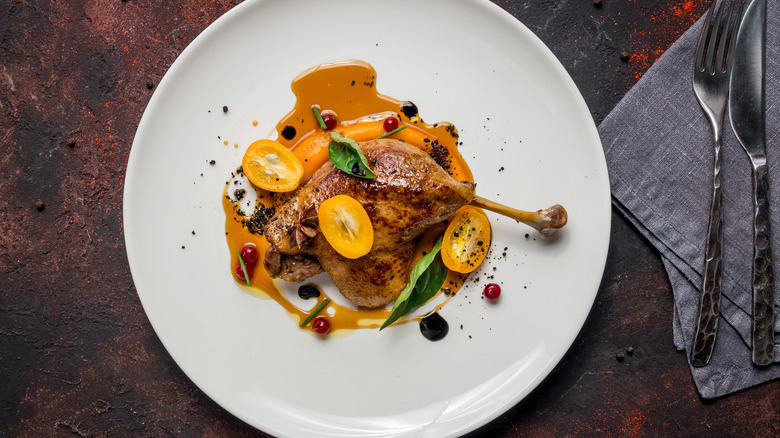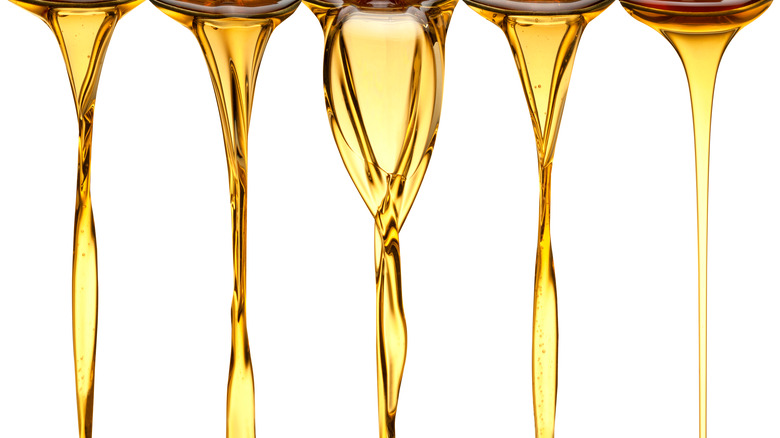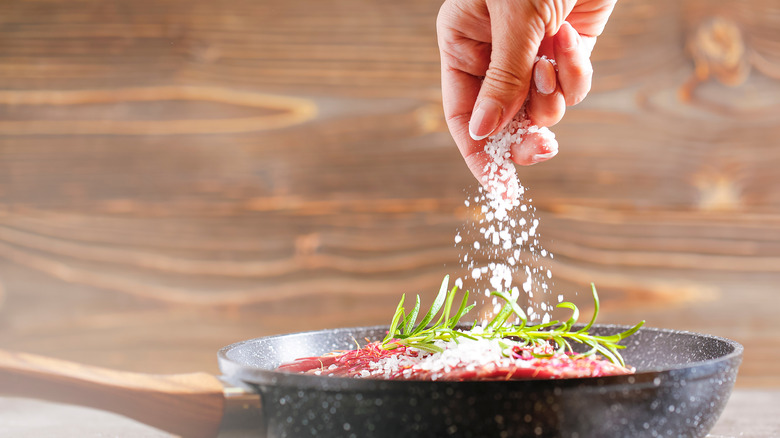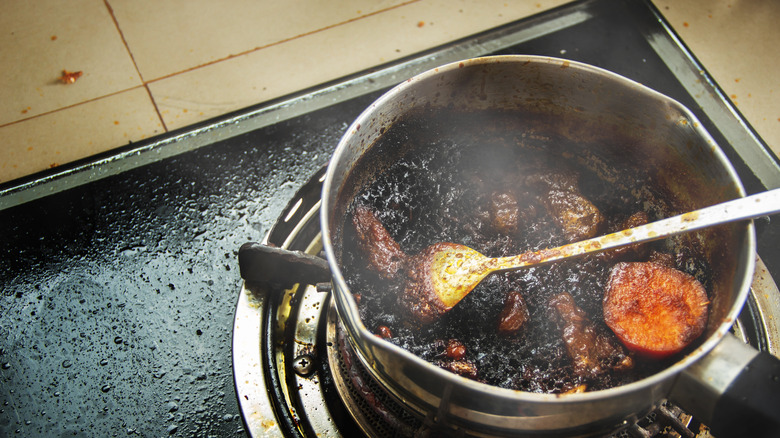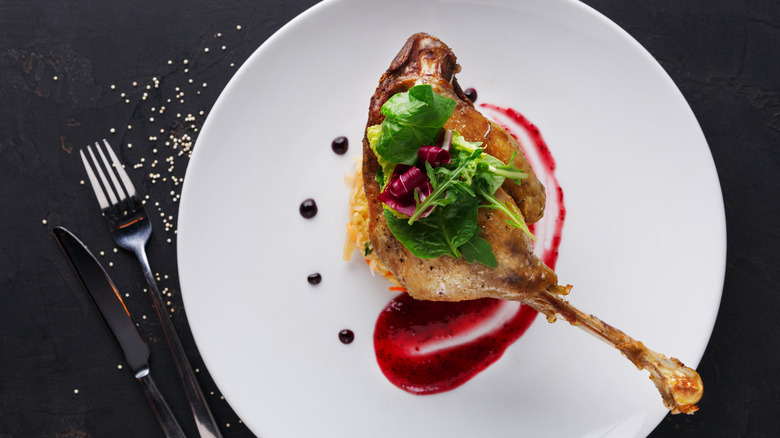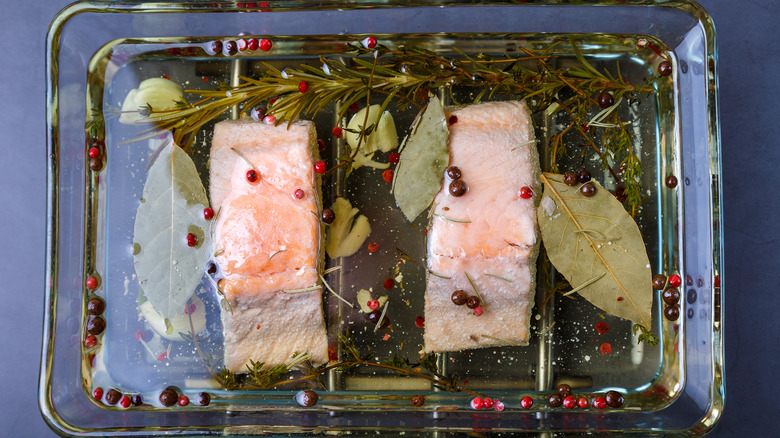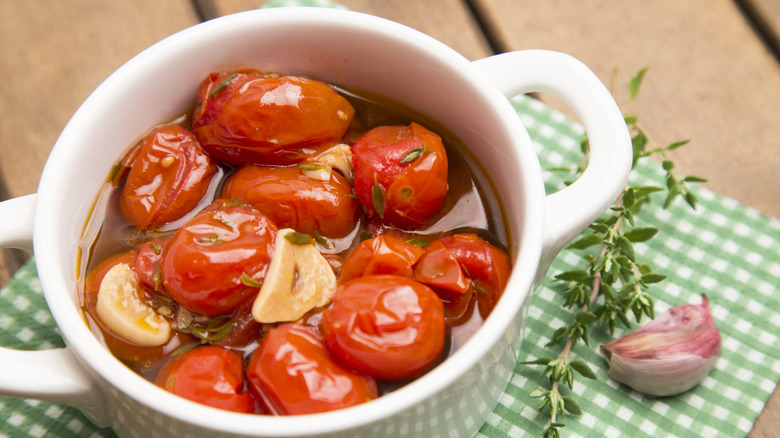The Biggest Mistakes You're Making With Confit
Confit, an elaborate-sounding dish that usually shows up at French restaurants, isn't something attempted by most home cooks. After all, confit is generally made with whole duck legs covered in epic amounts of duck fat — not the simplest recipe to tackle in the world. Who has gallons of fat lying around? And where does one even begin with such a recipe?
But when done right, confit is delicious, filled with deep savory notes and a splendid, melt-in-your-mouth texture. As a bonus, confit is also long-lasting, keeping up to six months in the refrigerator (via Food52). However, a good confit is a time-consuming process, with several steps of curing, cooking, and resting. Because it's such a technique-driven dish, there's plenty of pitfalls for the inexperienced confit maker.
Despite these obstacles, making confit is well-worth the effort and not as intimidating as it sounds. All you need are the right techniques, ingredients, and patience. Of course, you would also need to avoid (and fix) these common confit making mistakes.
Believing confit is inherently greasy
First, what exactly is confit? According to chef Thomas Keller, confit is the French word for "preserve" and consists of salt curing and slowly cooking an ingredient in fat. The most popular version of confit is made with duck meat and fat, although other meat like pork can also be used for confit. Texture is one of the best things about a well-executed confit. "If you imagine a really good BBQ or braise — something that's soft, tender, and juicy — that's how a good confit should be," said Ashish Alfred, owner of Alfred Restaurant Group in the Baltimore, DC metro area, to Tasting Table.
At first, the amount of fat used in confit can seem excessive and greasy to the inexperienced. While this is a misunderstanding, it isn't completely unreasonable. Since confit is all about cooking in pure fat, it seems awfully similar to deep-frying, a cooking method famous for its heavy grease. This misunderstanding can lead some people to assume that confit is inherently a fatty dish, shares Serious Eats.
The key to correcting this mistake is understanding the differences between confit and deep-frying. Although it's true that confit is submerged in fat during cooking, that doesn't mean it's being deep-fried. Deep-frying is done at a high temperature to ensure crispy texture. In comparison, confit is cooked for hours at a low temperature to tenderize meat without any moisture loss (via Serious Eats). "There is not a fine line between deep-frying and confit — they are two very different things. By definition — the proper technique is low and slow," explained Alfred. In essence, the differences between confit and deep frying can be compared to the differences between barbecue and grilling: low and slow versus high heat charring.
Over-seasoning or under-seasoning confit
A properly made confit should be a revelation, a food that's richly tender and well-seasoned. When improperly seasoned, confit can easily become either too salty or lacking in flavor. To avoid this, it's important to first understand how confits are seasoned. Confits are seasoned with a salt cure, which (besides salt) can also contain herbs like pepper, thyme, leeks, or bay leaves (via MasterClass). This salt cure happens before the ingredient is submerged in fat for cooking.
According to chef Thomas Keller, the addition of a salt cure "draws out the moisture — replacing the water with oil — making the meat ingredients more tender and adding depth to the flavor." First, before any cure is applied, the meat should be patted dry of moisture. Because the cure is intense, it's really important to rinse off the meat before cooking to avoid the confit becoming too salty (via Serious Eats). When it comes to salt curing times, there are several different schools of thought. While chef Thomas Keller states curing times can be as short as an hour, Serious Eats advises an overnight cure for traditional confit.
Cooking confit at too high a temperature
Because confit is centered on slow-cooking, temperature control is imperative. If the cooking temperature is too high, you'll end up deep-frying your ingredients instead. Even the temperature of the fat is important. In an article for Food & Wine, chef Philip Brazil at The K Club in Ireland recommends using cold or room temperature fat for confit.
The best temperature for confit will be much lower than a typical deep-fry, which usually ranges between 325 degrees Fahrenheit to 400 degrees (via Serious Eats). For confit, the temperature is much lower, hovering around 200 degrees, although this temperature can vary depending on recipe and individual preferences, with some confit temperatures going as high as 300 degrees, according to Food52. "I recommend cooking duck confit at 200 or 225 degrees," Ashish Alfred told Tasting Table. "If it's too high, you risk deep frying and losing the soft, unctuous texture. If it's too low, you either won't get the desired effect, or will take forever to cook something that shouldn't take long."
Not enough space to cook or store confit
Now that you're done with the cooking part, there's another mistake that's common for confit newcomers — storage space. Confit is quite a culinary undertaking, requiring a great deal of space. A common rookie mistake is not planning enough cooking or storage space for your confit. Obviously, the biggest cause of the space issue is the copious amount of fat that's needed for confit — not only do you need a big enough pot for cooking, you also need enough space to store it when it's finished.
An easy way to fix this mistake is to simply check and clear enough space in your fridge before you begin your confit journey. Since most confit will be cooked in a large Dutch oven or heavy baking dish, your fridge needs to have enough free space to store it without causing issues with other items. Remember, confit is a long-term food with items like fruit confit even lasting for years (via Serious Eats).
Another way to save space is to change your confit cooking methods, particularly the meat. According to Serious Eats, sous vide duck confit is a good, modern method that also saves space. Instead of configuring ways to fit a large pot of fat and duck into the fridge, it's much easier finding space for an airtight plastic bag of duck legs.
Not letting your confit sit
Time is an important element to the art of confit. "The most common mistake is lacking patience," Ashish Alfred told Tasting Table. "It's also not something that you're just going to be able to pull off an hour before a dinner party — it requires preparation."
There's two main reasons that a finished confit should be rested before eating: flavor and texture. For many confit traditionalists, a confit, especially duck and meat, isn't truly a confit unless it's aged (via Serious Eats). As a confit sits in fat, the flavor changes, maturing into something rich with layers of umami funk. This aging process for flavor is similar to any aged food such as cheese, wine, or cured meat — all items that increase in complexity over time. As food writer Paula Wolfert states for New York Times Magazine, "freshly cooked confit can be superb. One-month-old confit is even better."
The other big reason for letting your confit sit texture. This is especially important for meat. For instance, a duck confit fresh from the cooking process will be too fragile to handle, shares Serious Eats. Also, since duck confit is especially delicious when crisped up in a hot pan, you'll want something firmer that won't fall apart. To create this masterpiece, wait at least a day before reheating your duck confit.
Skipping confit fish
One of the biggest confit mistakes is assuming it's all about the meat. While duck and pork are obvious (and delicious) confit ingredients, don't sleep on fish. When properly executed, fish is actually one of the tastiest ingredients to confit.
So what types of fish are good for confit? Surprisingly, the answer is pretty much any fish. Most of the commonly enjoyed firm-fleshed fish, such as salmon, tuna, and cod, are excellent for confit. Although even more delicate-fleshed fish like pollock, hake, or sea bass can be great options, shares Great British Chefs. Like meat, fish confit requires a salt curing process before it's placed into a fat. The exciting part about the confit process for fish is the different herbs that can be infused in the fat, such as thyme, garlic, and even fennel.
Which leads us to a common mistake that can occur when making confit fish — not adjusting the salt curing time. Food52 recommends a shorter salt curing time for fish confit than duck and meat — a shade under 30 minutes or you risk the fish over-drying. While different species of fish are great for confit, the times and temperature will need to be adjusted depending on the fish.
Not using vegetables or fruit for confit
Another confit faux pas is neglecting the abundance of fruits and vegetables. Remember, confit is a food preservation process using salt and fat — there's nothing in its mission statement that bans plants. In fact, pretty much any kind of vegetable is excellent for confit, says Epicurious. Our advice? Think outside the box. Garlic confit is a traditional choice but vegetables like parsnips, carrots, and even potatoes can be delicious as well (via Food52).
A key step to remember when preparing vegetable confit is to make sure that all the pieces are consistent in size. While small or thinner vegetables like green beans can stay whole, larger vegetables should be chopped into large, uniform pieces. For oil, add an amount that seems excessive, at least halfway up the sides of the veggies. (Epicurious says covering it completely is "even better" since that requires less checkup on the cooking progress.) Finally, the oil itself — it's crucial that you use a good-quality olive oil for confit vegetables. The main reason is the flavor profiles — spicy and savory — elements of high-quality olive oil that can accelerate the flavor of your veggie confit. Cheaper and lower quality oils will not have these layers of flavor.
But what about fruit? Like veggies, Food52 recommends all manners of fruit — from cherries to pears — for confit. Unlike meat or vegetables, fruit confit is made without salt and replaces the fat with sugar syrup. To confit fruit, be sure to remove all the moisture, a time-consuming process that can take multiple days and a lot of sugar. To up the flavors of your fruit confit, consider adding herbs and spices to the sugar syrup. The end result will be an intensely sweet fruit dish that's absolutely delicious as a topping or side.
